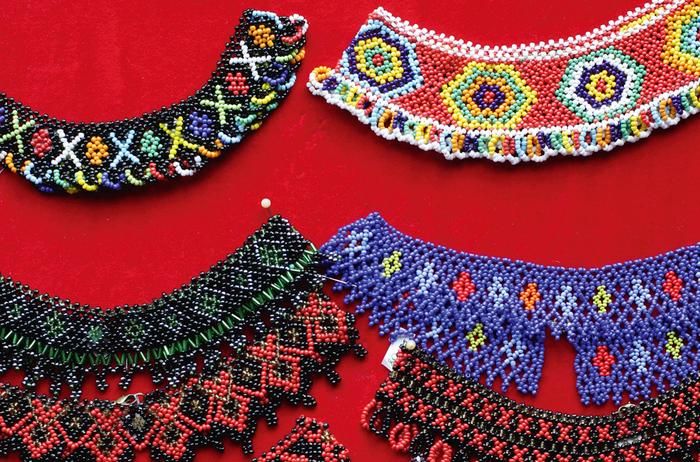

Krywulka is the most characteristic element of the Lemko women's jewelry. It spread in the eastern part of the Lemko region in the interwar period, displacing very expensive coral necklaces, while in the western and central Lemkos regions the role of the coral was taken over by the so-called inner tubes.
In the mid-nineteenth century, krywulki were made by threading glass beads on several strands of horsehair. Due to the impermanence of the material, horsehair was replaced with linen and hemp threads at the turn of the 20th century. Gradually, over the course of the 20th century, cotton threads began to be used. Nowadays, synthetic lines are used. Glass beads in the nineteenth century usually came from Venice. From the beginning of the 20th century, they were imported from the Czech Republic. Lemko caps were made of beads with a diameter of even about 2 mm. In the eastern part of the Lemko region, elements made of other materials, such as crosses and medals, were also attached to covers made of small beads. Lemkos were made with a needle or on specially used looms. Younger women learned the skills of making ornaments from glass beads from their older ones, e.g. daughters from mothers, later competing with each other in creating the prettiest and the largest covers. The choice of color combinations and the finishing of the necklace depended on the creativity of the performer, although the design of the jewelry itself was limited by the technique of execution, which imposed certain solutions. In the Lemko region, against a background of very small red or maroon beads, geometric patterns in the shape of circles, squares, rhombuses, hexagons and stripes were created.
Before the mid-twentieth century, it was worn with a festive outfit over a shirt and a corset (a kind of corset), but it was also worn as an ornament of everyday clothing, if a woman could afford to have several sparrows, possibly additionally putting on other strings of beads that wrapped tightly around the neck or hung freely on top of a wider necklace. Bead jewelry was worn by both girls and mature women.
Wealthy Komanian women wore real beads, sometimes they had crosses on their pearls. They also wore covers made of tiny beads. “The colors of the krywulki were red, there was a viburnum color, there was a coral color, there was a red color that fell into a claret. They were all kinds of covers. And whether there is the left side or the right side, it is the same. And the beads were very expensive, the string of beads cost fifty cents. The fifty-penny man worked all day.
An iconic figure has become Daria Boiwka, who is still a kind of "brand" in the creation of Lemko jewelry (krivulki, hardany), she also infected her granddaughter with this skill, who is also great at creating and developing new patterns of beads. Another person who cultivates the old traditions of ornaments and also lives in Komańcza is Teresa Wasylów. She also deals with cross-stitch
and creating covers.
Ewelina Matusiak-Wyderka "Thumbelina", a graduate of the People's University in Wzdów, lives in Wola Sękowa in the Bukowskie Foothills. It deals with the production of Lemko jewelery, in particular krywulek and hardan. The "Kuźnia Łemkowska " gallery was opened in Komańcza near the Greek Catholic church. You can find souvenirs there and enjoy simple food.
In the village of Komańcza there is a private collection of Lemko memorabilia of Daria and Stefan Boiwek in Komańcza. The memorial room in Komańcza was established by Mr. and Mrs. Daria and Stefan Boiwek and is located on their farm. The exhibition is devoted to the Lemko culture and is a private family collection. The collection includes, among others: souvenirs of the Boiwek family, items used on a daily basis in the household, an original Lemko garland, a quern with traditional, original Lemko costumes from the area of Komańcza, Łupków, Dołżyca, Osławica, Prełuk and Duszatyn. In addition, the home archive contains original patterns documented on graph paper along with the colors of the local Lemko embroidery. Daria Boiwka contributed to the creation of the Lemko culture handicraft gallery, she also conducts traditional embroidery and knitting workshops. Currently, the chamber is taken care of by the granddaughter of Daria - Katarzyna Duduś.